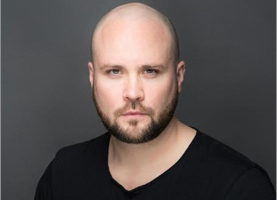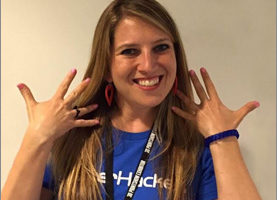Asthma, restless leg syndrome, obstructive sleep apnea, narcolepsy…these are just a few of the medical problems that can coexist and underlie behavioral sleep problems in children. Generalized anxiety and post-traumatic stress disorder can also cause sleep problems in children over the age of six, and should absolutely be ruled out prior to any sleep coaching. These are just a couple of the topics Kim West, family therapist and author of Good Night, Sleep Tight, discusses on today’s episode. For over 20 years now, she’s been known as “The Sleep Lady”, a testament to the focus of her work and her success in helping both children and parents in this area. She discusses different methods used for coaching children under six months of age to fall asleep well, and why she believes the method she’s developed—which she refers to as parental fading or The Sleep Lady Shuffle—is the healthiest for children and parents alike.
Tune in to hear the full conversation and learn more by visiting sleeplady.com.
Richard Jacobs: Hello. This is Richard Jacobs with the future tech and the future tech health podcast. I have Kim West. She’s the founder of a company on a website called sleep lady. She’s referred to as the sleep lady. It’s a trademarked term for her. She’s also an author. So Kim, thanks for coming. How are you doing?
Kim West: Thank you. Thanks for having me.
Richard Jacobs: How did you become the sleep lady? How did you get that name?
Kim West: Um, well, I’ve been a family therapist for over 25 years and when I started to work with babies and sleepover, you know, over 20 years. Oh, go to, um, I had a client who was three years old and I was calling to check up on how his sleep was going, uh, with his mom. And he’d heard me talking about him and his mom talking about him and he actually gave me the name. He said, mommy, are you talking to the sleep lady? And I said I liked that, I liked that. But how I became your sleep lady was when I was pregnant with my first daughter and my older brother and his wife had just had their first son who wasn’t sleeping and they were a wreck, you know, they’re stressed out. Um, they were feeling like their work performance was being affected. They were saying things like, I’m never having any more children and I thought, oh my gosh, is this a problem that I didn’t even think that that would be a problem, you know, as a pregnant mom. And, uh, so I began to research and um, figure out a way that I could use my, my background, my master’s in, in child and family development to help me and he actually had the baby and had to, um, and I got, while I should say I got some bad advice unfortunately. And so I had to kind of go inward, figure out another way to do things differently. And I really wanted to, at that time, there was only one method, um, which was Ferber, um, what they call in the United States is Ferber. In other parts of the world, they call controlled crying. I call it a time check.
Richard Jacobs: Server?
Kim West: Ferberizing. Because Dr. Richard Ferber was the first author and the first doctor. Yeah.
Richard Jacobs: Like raising, uh, raising a fervor. F. E. R. V. O. R.
Kim West: I know. Yeah. I mean he, I, my understanding is that he doesn’t love that his name has become a verb.
Richard Jacobs: Maybe he is the one that made the Furby,
Kim West: No, I don’t think so, but yeah, would be funny. Um, it, his method is basically called graduated extinction. So, um, where you put the baby in a wait awake. You leave them and you check on them in timed and comments. Um, and then the other method is, uh, really become popular by Dr. Wise Bluff and that’s full extinction. Put the baby in the crib, leave the room, don’t go in all mine, no matter how long they cry. And, uh, I was uncomfortable with two of those, those two methods. I also know that they don’t always work cause never does one thing for everything. And because I’m such a supporter of a secure attachment, I, uh, came up with a gentle method, um, that we’re referring to as parental fading. So you don’t leave your baby or child to cry alone to go to sleep.
Richard Jacobs: Right. Okay. So what’s the, what’s the method look like in comparison?
Kim West: Yeah, so you put the baby or child into their bed awake, right. We all kind of say that and then, uh, you stay with them and you stay and offer, you know, physical and verbal reassurance, even pick up to calm if needed. And you do that at bedtime and each waking at night until they’re asleep and every three nights you move farther away from the bed. So, therefore, you’re doing less and less as your child begins to incorporate the skill independently. So it’s just an option just like any, all the other methods, my method, which has been coined, the sleep lady shuffle, uh, is, you know, not a one size fits all. Um, but it’s an option for those parents who don’t want or can’t or tried a more crying out methods and it didn’t work. So I like, I feel like parents really, really need those options and they all, because I should say because to be consistent, once you start sleep training, uh, you really need to pick the method that you’re going to be able to follow through with consistently. And that’s the right match for your child’s temperament and your family philosophy.
Richard Jacobs: But what happens if you getting further away and being there last and then there’s the bad night, like the kid is sick or for some reason they’re just, Eh, nothing calms him down, they keep crying. What do you do then? Do you move closer in a few steps and reset? You reset all the way and what do you do?
Kim West: Yeah, well, I mean, some of it obviously depends on the details of, of how long they, the parents have been, um, sleep coaching, what’s the age of the child. But in general, uh, I would recommend that if a child gets sick in the middle of sleep training, I’ve had you, you know, move closer. Um, or if you’re already sitting close because they got sick in the first three, three to four nights, and then I might have you stay in that position longer. So sort of pause if you will.
Richard Jacobs: Okay. You mentioned this it’s mostly for newborns or what about older children?
Kim West: Yeah, no, my book goes from, well, I talk about babies under six months, but I really don’t recommend full-on night and not coaching until six months. Sometimes you can start a little bit earlier. Um, but really each baby under six months needs to be assessed. Um, but it’s six months to six years of age.
Richard Jacobs: Hmm.
Kim West: I mean, I personally worked with older kids in my practice, um, as a therapist. Uh, but you know, if you’re talking about just straight up behavioral sleep problems, um, my, that’s the age group that my book covers.
Richard Jacobs: Do you have a, um, What if the older kids if they have a traumatic event, they started wetting the bed or bad sleeping or I mean nightmares
Kim West: For, for a child over six?
Richard Jacobs: Yup.
Kim West: Yeah. I’m sorry, I didn’t hear the beginning of your question. So for a child over six, uh, one of the reasons why I don’t address that in my book, um, but have addressed it in my practices. Sometimes you have to rule out generalized anxiety disorder or if they had a traumatic event, PTSD, post-traumatic stress disorder and they may need, um, some even short term psychotherapy. You know, you don’t want to, you know, you have to address the potential underlying problem. The other thing that also gets missed with, um, behavioral sleep problems is sometimes they, they are coexisting with an underlying medical sleep problem. So allergies, asthma, in particular, the medication to treat asthma, reflux, uh, restless leg syndrome, obstructive sleep apnea, even with some older children in narcolepsy.
Richard Jacobs: Hmm. Okay. Do you recommend that, uh, you know, you suspect your child’s having a problem, maybe sit with them after they go to sleep and watch them for a few minutes and see if they’re snoring or if they’re thrashing or doing things and maybe a couple of times during the night
Kim West: Um, I always recommend it. Sometimes it’s hard to know that because we often will, for instance, snore in rem sleep, which is later at night. Uh, but certainly if the parents really concerned and they don’t have a monitor, they could either get a monitor or borrow a video monitor and watch their child that way where they could sit in the room if they felt comfortable. But I always have parents before we start sleep training or coaching, get what I like to call the green light from their pediatrician so that we’ve done at least as much due diligence as we can. And then in my history form that every parent fills out before we start sleep training. There are lots of questions to help them rule out and to help me know whether they need to be referred out. Uh, for instance, common signs of even just obstructive sleep apnea are sweating, uh, particularly in the head, a snoring, mouth breathing, restless sleep. Those are the top.
Richard Jacobs: you said pickling of the head? What does that mean?
Kim West: No, I said sweating. Particularly on the head.
Richard Jacobs: Oh, Particularly on the head. I thought that was a new phenomenon. Yeah. What ages have you seen, uh, you know, these things happen in all ages or is there a more typical range when it happens?
Kim West: uh, the medical, the underlying medical or,
Richard Jacobs: yeah, the medical, well, yeah, both the medical stuff and the way medical and then just the, yeah, the weaning, the self-soothing, and boy being able to sleep in there.
Kim West: Um, so the youngest age I’ve ever seen a baby with obstructive sleep apnea as opposed to some of the kind of apnea is a baby can have when their premature is nine months of age. Uh, I see it more commonly, uh, in my practice and in doing public speaking with, uh, two, three, four, five-year-olds, um, and just went undiagnosed, uh, not, not uncommon. So behavioral sleep problems. I mean, honestly, I think that under six months babies are so different. Um, and you’re much more fragile if you will. And, uh, and you know, some can have reflux, some could be born early, all kinds of factors that make it harder. There’s not like a big fat bell curve like there is with the kids over six months. So I wouldn’t even say there’s a particular age group that’s more popular than another to have sleep problems. I think maybe sometimes parents get to six months and they’re like, well I can suffer for a few, a few more weeks or a few more months since say you might see a lot of babies, you know, eight, nine, 10, 10 months of age. But really, really pretty much six months to five years of age is, is very common all along there. And the common types of what I call sleep crutches. So maybe I should just back up and tell you what a sleep crutch is. So in the, in the behavioral sleep science world, they call it a negative sleep association. So anything that has to be done to you or for you to put yourself to sleep and back to sleep. So I always tell parents like to think back to the day before having kids. Um, maybe you, ha and as a woman before being pregnant, cause lots of women have disturbed, you know, sleep problems on reflux as an example and they’re pregnant. But think back when you had to go to bed earlier, let’s say you have a really early flight in the morning, you know, one of those 6:00 AM flights and you tried to go to bed earlier than you normally do. So maybe you, you know, took a warm shower, maybe, you know, read a book, maybe did some Yoga, deep breathing, and then you had to still do something to turn your thoughts off, uh, at night. So you really are actually doing something to help yourself go to sleep. It really is a skill. And then you have to apply that during the night because we all have what’s called partial arousals. And as we cycle in between rem and non-rem sleep, so do our babies. Uh, there’s uh, you know, there are sleep architecture develops in the first two years of life, soap mimics and adult. But either way, they have rem and non-rem and so when you cycle in between, this is when you may have partial arousal, some large, we largely don’t even wake up for them. You and I, if we have good sleep, um, and we don’t have any negative sleep associations, but if you did, you know, you wake up and you’d need whatever it was done you to help you get to sleep, to begin with. So if a child is, let’s say rocks to sleep in a parent’s arm at bedtime, they rock the baby, put them in the crib, Kinda sneak out of the room, hope they stay asleep. And then every time they wake up in between those partial arousals are those sleep cycle transitions. They’re going to need the parent to come back in and rock them back to sleep. And so this tends to get worse and worse over time often. Uh, and I, I also find that parents start adding on new sleep crutches. Like, oh, I used to be able to nurse you to sleep and put you down and everything was great. And then I had to start nursing you and rocking you and then I had to start nursing you, rocking you and balancing you to get you to sleep. And before I know it, you know I doing this for half an hour and I put you down the crib and you still wake up right away. And that’s usually when the parents are calling me or one of my gentle sleep coaches and saying nothing we’re doing is working anymore. We need help. Our child’s getting up, you know, six, eight times a night.
Richard Jacobs: And what are the crutches need to multiply in the first place. And why do you think that happens?
Kim West: I think it’s sort of like it, it, it’s like the loses its strength, its or we build up a tolerance if you will. No, no that’s not true for all children. But I have found that to be common. I think part of it is because it’s kind of loses its strength if you will. Um, but also our kids are just getting smarter after a while they figure out like, oh, so you are going to put me down when I’m um when I’m just about asleep or almost asleep and a, and I figured that out and then I wake up and I’m upset. And then I want you to pick me back up some super common.
Richard Jacobs: So what’s the solution? Do you vary the, uh, the crutches? Does that work better or you know, do them in a different order or what do you?
Kim West: uh, well usually we just have to wean off the crutches. So, um, we always have to put our children to bed or at least this is the goal. The first goal and sleep coaching is to, um, put your child down awake at bedtime after a soothing bedtime routine after a great day in Apps, any way you can get them. And in early enough bedtime, really getting that, we can talk about this too, if you want that sleep window, right? That’s in sync with the circadian rhythm. Um, and then we help them and stay with them while they’re learning this new skill, which can be super frustrating for them. You can imagine it’s, uh, they’re not going to if they’re pre-verbal, they’re not going to understand why you’re changing your ways. And then if they are verbal, they’ll be upset. They’ll cry and they’ll have words for you. Like, no mommy, I can’t do this. Or Daddy lay down with me. They don’t understand why you decided to suddenly change the routine.
Richard Jacobs: So you just have to um, let them apply to one session of this or how many times?
Kim West: Well, it depends on what, what sleep coaching method you use, right? Extinction, graduated extinction or parental fading. So you know, if you use my method and parental fading, you would stay with your baby or child, you’d offer physical, you know, padding, shushing, humming, singing. It’s okay honey, I’m here for you. If they get really hysterical, a hug, the whole, the pickup to calm, a put down, really trying to help them. And over the first three nights doing less and less as they start to learn the skill. And all of a sudden, a lot of parents will say, oh my gosh, he’s started to pull it on his ear or, or rub the sheets or lift their legs up and plop them down. And you see them starting to learn what makes them feel good and helps them go to sleep themselves. It’s really empowering.
Richard Jacobs: I remember I used to do, um, I used to lay with my kids and I tried the lights and my son would say, I can see, you’re not supposed to see in a bed. Yep.
Kim West: Yeah. Huh.
Richard Jacobs: Maybe just a hang out with them in the darkness, you know, with no radio or TV or any of that stuff, we’re falling. Maybe that’s a common way to help things as well.
Kim West: Definitely no phones for our kids or TVs in their room would be really helpful. I mean, screen time, you know, I, it’s an eye. Ideally, you want no screen time for an hour, even better two hours before bedtime because you know, the screen time teaches there, tells the brain not to secrete that drowsy making hormone Melatonin. Um, so it makes it harder to go to sleep and stay asleep. And apparently, there’s lots of bill in the United States that have TVs in their room.
Richard Jacobs: So what’s, um, how long does it usually take the full program? So that I guess the end goal is for the, uh, it tried to sleep consistently through the whole night without having to have him to go in there at all.
Kim West: Yeah. So, uh, if the child, for instance, is old enough and healthy enough and growing and everything to sleep through the night without a feeding, right, in terms of like a baby, but yes, that’s the goal. I would say an on average it takes seven to 10 nights, uh, for the baby, let’s say, to start to largely sleep through the night. And then the morning nap starts to be, well naps, in general, take about two to three weeks. And then the morning that falls into place first. And then in the afternoon. Now, slightly older kids and kids in, in beds, uh, especially ones who parents had been really inconsistent for several years, they can take more like two to three weeks. Um, cause they can also get out of bed and negotiate more, you know, stall tactics, all those other things that, you know, babies and cribs can’t do.
Richard Jacobs: Here are both sides. They can never stop.
Kim West: Yeah.
Richard Jacobs: Even when they’re older, I noticed that they just evolved.
Kim West: Yeah, exactly. I mean I get that, you know, part of it is that our children just want to connect with us. You know, they’d have a long day and you know, with school and playing or even sports. And that’s really why bedtime, bedtime routine is so helpful. Uh, it’s really helpful for us as adults. Um, and for our children’s who can have that kind of last connection before we go for the big night separation.
Richard Jacobs: Make Sense. Okay. So you said that um, how will you have a network of pediatricians that refer your program or did people find out about your program first and then ask their pediatrician about it or how do you, how do you get clients?
Kim West: I would say my two main sources in the last 25 years have been a word of mouth because you help a family and you get their baby and child’s sleeping through the night and their life transforms and they tell everyone, I mean sleep is just the most amazing gift. And then they’ll go back and tell their pediatricians and uh, and then the pediatricians are so grateful to have, you know, a general sleep coach or me, uh, available to refer to. And then I just end up having pediatricians refer to me too. Yeah.
Richard Jacobs: What’s the best way for people to find out more to get into contact?
Kim West: yeah, so you can go to sleeplady.com I have three books you can look at on Amazon, the sleep ladies, a good night sleep tight, the good night sleep tight workbook. And I now have the good night sleep tight workbook for children with special needs and on sleeplady.com/coaches you can see a directory of my gentle sleep coaches that are all over the world and I think in about 15 different languages. So there, and they can all, they can work for you virtually.
Richard Jacobs: Oh, you can do it over Skype and everything.
Kim West: Yeah.
Richard Jacobs: That’s great. Excellent. Well, very good. Well, Kim, I appreciate you coming on the podcast.
Kim West: Thank you for having me.
Richard Jacobs: Okay. All right.
Podcast: Play in new window | Download | Embed











